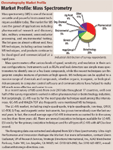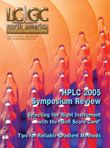Peaks of Interest
Millipore Corporation (Billerica, Massachusetts) announced that it recently has acquired over 90% of NovAseptic AB (Gothenburg, Sweden) shares. Millipore is in the process of acquiring the remaining shares from the minority shareholders.
Millipore acquires NovAseptic AB
Millipore Corporation (Billerica, Massachusetts) announced that it recently has acquired over 90% of NovAseptic AB (Gothenburg, Sweden) shares. Millipore is in the process of acquiring the remaining shares from the minority shareholders.
Martin Madaus, Millipore's chairman, CEO, and president, noted, "NovAseptic brings innovative and differentiated products that our biotech and pharmaceutical customers value highly for manufacturing biologics and for monitoring biomanufacturing processes."
NovAseptic provides a range of solutions for aseptic-processing applications in biotech and pharmaceutical manufacturing operations.

Market Profile: Mass Spectrometry
Applied Biosystems supports research into DNA signatures
The Translational Genomics Research Institute (Tgen, Pheonix, Arizona) and Northern Arizona University (NAU, Flagstaff, Arizona) announced recently the award of a multimillion dollar grant from the U.S. Department of Health and Human Services to improve the understanding of two leading causes of death for most age groups worldwide, sepsis and community-acquired pneumonia (CAP).
Applied Biosystems (Foster City, California) is supporting the project to discover pathogen-specific DNA signatures. These signatures will be used to design and validate Applied Biosystems TaqMan real-time PCR assays for the accurate identification of these life-threatening infections.
EMD opens chromatography center
EMD Chemicals, Inc. (Gibbstown, New Jersey) recently unveiled its new Chromatography Technical Center in Gibbstown, New Jersey. The center will be equipped with a wide range of chromatography columns and staffed by expert personnel.
The new center is expected to be operational by the end of 2005. Standard training sessions will be offered regularly, and custom-designed programs will be available to respond to individual customer scheduling and content requirements. In addition, EMD will continue to provide training at customer locations.
GTC Biotherapeutics receives notice of allowance on purification patent
GTC Biotherapeutics, Inc. (Framingham, Massachusetts) announced recently that the U.S. Patent and Trademark Office has issued a notice of allowance for the claims in its patent application 10/635,117 covering tangential flow filtration technology. These claims provide the company with a unique position in the use of this technology to recover recombinant therapeutic proteins that are expressed in the milk of transgenic animals.
The patent that issues from this application will expire in 2023.
Inverness Capital Partners invests in NCSRT to expand operations
Inverness Capital Partners (Philadelphia, Pennsylvania), a $125 million private equity fund, has invested in NCSRT, Inc. (Apex, North Carolina), a designer, developer, and manufacturer of filtration solutions.
Henry Kopf III, NCSRT president and CEO, says that the investment will allow NCSRT to expand operations and continue to provide customers with industry-leading technical support.
HPLC 2025 Preview: Fundamentally Speaking (Part 1)
May 13th 2025Michael Lämmerhofer from the Institute of Pharmaceutical Sciences, University of Tübingen, Germany, spoke to JFK Huber Lecture Award winner of 2024 Torgny Fornstedt, professor in analytical chemistry and leader of the Fundamental Separation Science Group, Karlstad University, Sweden, about his pioneering work in high performance liquid chromatography (HPLC) with a focus on fundamentals and industrial applications.
Determining Ways to Protect Honeybee Colonies with GC–MS
May 13th 2025A study conducted by the Agriculture Research Centre of Giza, Egypt, and Jilin Agricultural University in China, evaluated the efficacy of stinging nettle extract, nettle smoke, and formic acid in the controlling of Varroa mites, a major threat to honeybee colonies, with a focus on mite infestation reduction, honeybee mortality, and biochemical responses. Gas chromatography–mass spectrometry (GC–MS) was used to identify key bioactive compounds in the stinging nettle extract.

.png&w=3840&q=75)

.png&w=3840&q=75)



.png&w=3840&q=75)



.png&w=3840&q=75)










